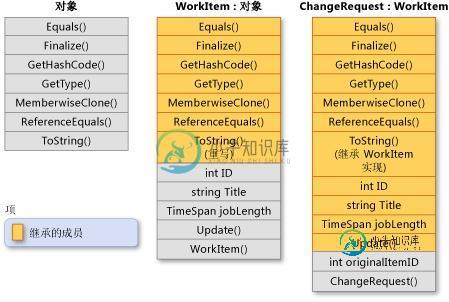详解C#面相对象编程中的继承特性
继承(加上封装和多态性)是面向对象的编程的三个主要特性(也称为“支柱”)之一。 继承用于创建可重用、扩展和修改在其他类中定义的行为的新类。其成员被继承的类称为“基类”,继承这些成员的类称为“派生类”。派生类只能有一个直接基类。但是,继承是可传递的。如果 ClassB 派生出 ClassC,ClassA 派生出 ClassB,则 ClassC 会继承 ClassB 和 ClassA 中声明的成员。
注意
结构不支持继承,但可以实现接口。
从概念上来说,派生类是基类的特例。 例如,如果您有一个基类 Animal,则可以有一个名为 Mammal 的派生类和一个名为 Reptile 的派生类。 Mammal 是一个 Animal,Reptile 也是一个 Animal,但每个派生类均表示基类的不同专用化。
定义一个类从其他类派生时,派生类隐式获得基类的除构造函数和析构函数以外的所有成员。因此,派生类可以重用基类中的代码而无需重新实现这些代码。可以在派生类中添加更多成员。派生类以这种方式扩展基类的功能。
下图演示一个 WorkItem 类,该类表示某业务流程中的一个工作项。和所有的类一样,该类派生自 System.Object 并继承其所有方法。 WorkItem 添加了自己的五个成员。其中包括一个构造函数,因为构造函数不能继承。类ChangeRequest 继承自 WorkItem 并表示特定种类的工作项。 ChangeRequest 在它从 WorkItem 和 Object 继承的成员中另外添加了两个成员。它必须添加其自己的构造函数,还添加 originalItemID。利用属性 originalItemID,可将 ChangeRequest 实例与更改请求将应用到的原始 WorkItem 相关联。

类继承
下面的示例演示如何以 C# 表示上图所示的类关系。该示例还演示 WorkItem 如何重写虚方法 Object.ToString,以及 ChangeRequest 类如何继承该方法的 WorkItem 实现。
// WorkItem implicitly inherits from the Object class.
public class WorkItem
{
// Static field currentID stores the job ID of the last WorkItem that
// has been created.
private static int currentID;
//Properties.
protected int ID { get; set; }
protected string Title { get; set; }
protected string Description { get; set; }
protected TimeSpan jobLength { get; set; }
// Default constructor. If a derived class does not invoke a base-
// class constructor explicitly, the default constructor is called
// implicitly.
public WorkItem()
{
ID = 0;
Title = "Default title";
Description = "Default description.";
jobLength = new TimeSpan();
}
// Instance constructor that has three parameters.
public WorkItem(string title, string desc, TimeSpan joblen)
{
this.ID = GetNextID();
this.Title = title;
this.Description = desc;
this.jobLength = joblen;
}
// Static constructor to initialize the static member, currentID. This
// constructor is called one time, automatically, before any instance
// of WorkItem or ChangeRequest is created, or currentID is referenced.
static WorkItem()
{
currentID = 0;
}
protected int GetNextID()
{
// currentID is a static field. It is incremented each time a new
// instance of WorkItem is created.
return ++currentID;
}
// Method Update enables you to update the title and job length of an
// existing WorkItem object.
public void Update(string title, TimeSpan joblen)
{
this.Title = title;
this.jobLength = joblen;
}
// Virtual method override of the ToString method that is inherited
// from System.Object.
public override string ToString()
{
return String.Format("{0} - {1}", this.ID, this.Title);
}
}
// ChangeRequest derives from WorkItem and adds a property (originalItemID)
// and two constructors.
public class ChangeRequest : WorkItem
{
protected int originalItemID { get; set; }
// Constructors. Because neither constructor calls a base-class
// constructor explicitly, the default constructor in the base class
// is called implicitly. The base class must contain a default
// constructor.
// Default constructor for the derived class.
public ChangeRequest() { }
// Instance constructor that has four parameters.
public ChangeRequest(string title, string desc, TimeSpan jobLen,
int originalID)
{
// The following properties and the GetNexID method are inherited
// from WorkItem.
this.ID = GetNextID();
this.Title = title;
this.Description = desc;
this.jobLength = jobLen;
// Property originalItemId is a member of ChangeRequest, but not
// of WorkItem.
this.originalItemID = originalID;
}
}
class Program
{
static void Main()
{
// Create an instance of WorkItem by using the constructor in the
// base class that takes three arguments.
WorkItem item = new WorkItem("Fix Bugs",
"Fix all bugs in my code branch",
new TimeSpan(3, 4, 0, 0));
// Create an instance of ChangeRequest by using the constructor in
// the derived class that takes four arguments.
ChangeRequest change = new ChangeRequest("Change Base Class Design",
"Add members to the class",
new TimeSpan(4, 0, 0),
1);
// Use the ToString method defined in WorkItem.
Console.WriteLine(item.ToString());
// Use the inherited Update method to change the title of the
// ChangeRequest object.
change.Update("Change the Design of the Base Class",
new TimeSpan(4, 0, 0));
// ChangeRequest inherits WorkItem's override of ToString.
Console.WriteLine(change.ToString());
// Keep the console open in debug mode.
Console.WriteLine("Press any key to exit.");
Console.ReadKey();
}
}
输出:
1 - Fix Bugs 2 - Change the Design of the Base Class
-
本文向大家介绍详解C++编程中的私有继承和公有继承,包括了详解C++编程中的私有继承和公有继承的使用技巧和注意事项,需要的朋友参考一下 C++类的私有继承 在声明一个派生类时将基类的继承方式指定为private的,称为私有继承,用私有继承方式建立的派生类称为私有派生类(private derived class ), 其基类称为私有基类(private base class )。 私有基类的公用成
-
面向对象的编程带来的主要好处之一是代码的重用,实现这种重用的方法之一是通过 继承 机制。继承完全可以理解成类之间的 类型和子类型 关系。 假设你想要写一个程序来记录学校之中的教师和学生情况。他们有一些共同属性,比如姓名、年龄和地址。他们也有专有的属性,比如教师的薪水、课程和假期,学生的成绩和学费。 你可以为教师和学生建立两个独立的类来处理它们,但是这样做的话,如果要增加一个新的共有属性,就意味着要
-
本文向大家介绍讲解C#面相对象编程中的类与对象的特性与概念,包括了讲解C#面相对象编程中的类与对象的特性与概念的使用技巧和注意事项,需要的朋友参考一下 类 “类”是一种构造,通过使用该构造,您可以将其他类型的变量、方法和事件组合在一起,从而创建自己的自定义类型。类就像一个蓝图,它定义类型的数据和行为。如果类没有声明为静态类,客户端代码就可以创建赋给变量的“对象”或“实例”,从而使用该类。在对变量的
-
本文向大家介绍C/C++ 公有继承、保护继承和私有继承的对比详解,包括了C/C++ 公有继承、保护继承和私有继承的对比详解的使用技巧和注意事项,需要的朋友参考一下 C/C++ 公有继承、保护继承和私有继承的区别 在c++的继承控制中,有三种不同的控制权限,分别是public、protected和private。定义派生类时,若不显示加上这三个关键字,就会使用默认的方式,用struct定义的类
-
本文向大家介绍JS 面向对象之继承---多种组合继承详解,包括了JS 面向对象之继承---多种组合继承详解的使用技巧和注意事项,需要的朋友参考一下 这一次要讲 组合、原型式、寄生式、寄生组合式继承方式。 1. 组合继承:又叫伪经典继承,是指将原型链和借用构造函数技术组合在一块的一种继承方式。 下面来看一个例子: 组合继承避免了原型链和借用构造函数的缺陷,融合它们的优点。 2. 原型式继承 可以在不
-
本文向大家介绍JavaScript面向对象程序设计中对象的定义和继承详解,包括了JavaScript面向对象程序设计中对象的定义和继承详解的使用技巧和注意事项,需要的朋友参考一下 本文实例讲述了JavaScript面向对象程序设计中对象的定义和继承。分享给大家供大家参考,具体如下: 在面向对象的Javascript编程中,希望代码优雅有高效是非常重要的。javascript中不存在类的概念,只有对

